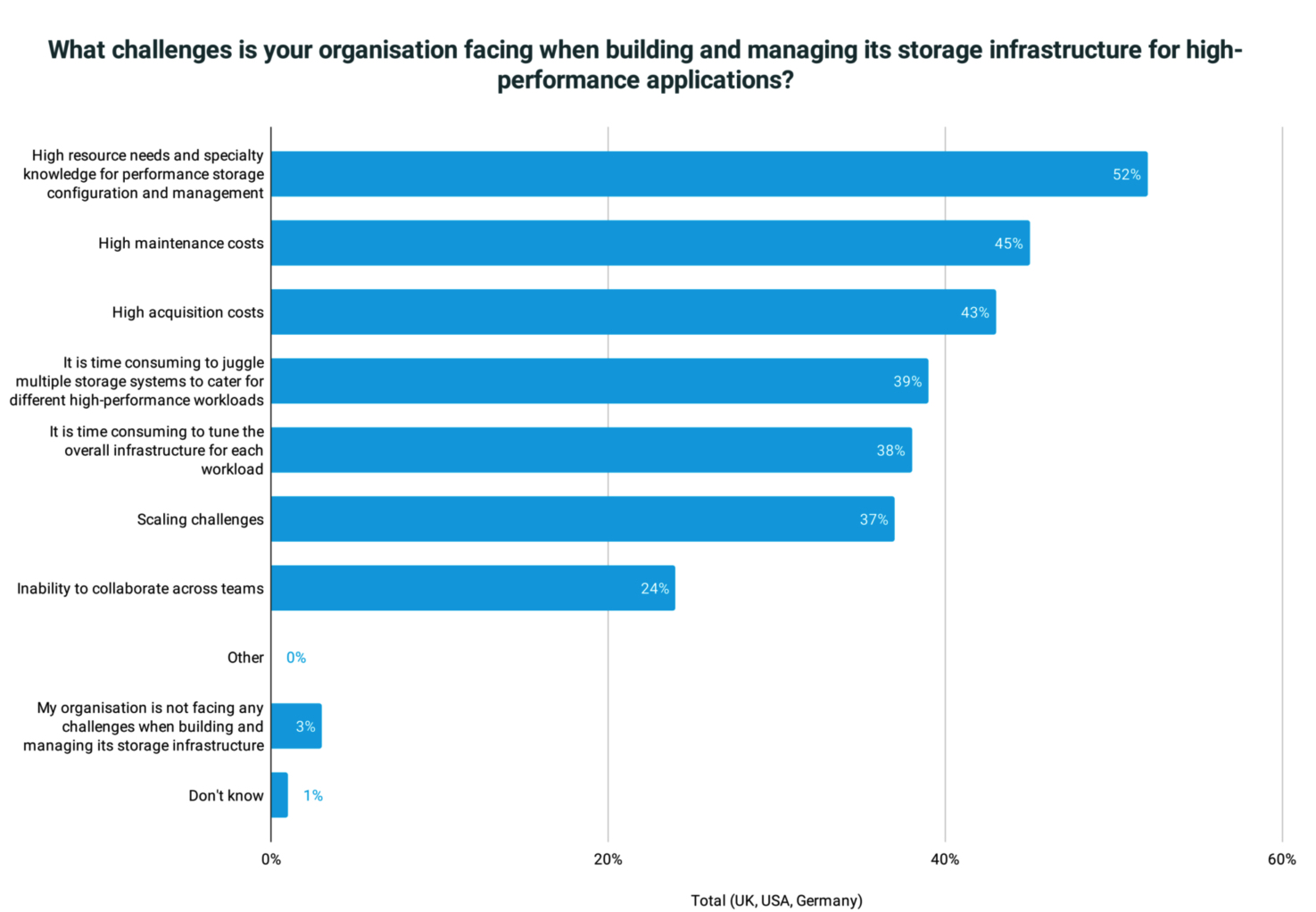Specialty Knowledge as Biggest Challenge for Managing High-Performance Storage
Panasas survey
This is a Press Release edited by StorageNewsletter.com on February 23, 2023 at 2:02 pmPanasas, Inc. announced results of a survey on the challenges enterprises face in building and managing storage infrastructure for high-performance applications. Lack of specialty knowledge coupled with high resource needs was the most frequently ranked challenge (over 50% of respondents).
The findings result from an independent survey by Vanson Bourne of hundreds of IT decision makers within enterprises with more than 1,000 employees across USA, UK, and Germany. Results reflect feedback across a broad range of industries, including financial services, manufacturing, commercial, retail, and more.
Intersect360 Research forecasts says that the HPC sector will continue to grow at a healthy rate, with HPC budgets expected to reach $59.2 billion by 2026 at a 7.7% CAGR.
This growth is further fueled by convergence of HPC with AI/ML and the role these technologies play in helping enterprises gain better insights to support business objectives. However, harnessing the power of HPC and AI/ML comes with new challenges. IT teams must have the tools and the people in place to manage the high-performance storage required to support current applications. As such, organisations must ensure that the storage infrastructure selected is scalable and versatile enough to successfully support future applications at scale.

Survey results show an overwhelming 96% of respondents face challenges in building and managing high-performance storage.
In addition to over half of respondents (52%) citing specialty knowledge as the top challenge, other key findings include:
• Nearly 50% of respondents across all 3 regions cited high maintenance costs and high acquisition costs as premier challenges at 45% and 43% respectively.
• Respondents from IT, tech, and telecom sector selected high maintenance costs as a challenge (44%) compared to high acquisition costs (36%).
• 39% of respondents across all regions stated that it is time consuming to juggle multiple storage systems to cater for different high-performance workloads, while 38% find it time consuming to tune the overall infrastructure for each workload.
• US respondents across manufacturing organisations (68%) cited specialty knowledge and high resources needs as the biggest challenge.
• US respondents across financial services organisations (53%) cited storage infrastructure to support application scalability as the most common challenge.
• With high resource needs and specialty knowledge for performance storage configuration and management cited as the biggest challenge across all industries, it was ranked highest among these industries: business and professional services sector (61%) followed by the manufacturing sector (60%) and the IT, tech, and telecoms sector (57%).
“We know what it takes to successfully manage HPC and AI/ML storage environments and the critical role these bandwidth-intensive applications play in supporting business growth,” said Jeff Whitaker, VP of product strategy and marketing, Panasas. “We long ago saw the challenges organisations face in managing storage infrastructures for high-performance environments, and these survey results reinforce those challenges. Our PanFS software suite demonstrates our commitment to delivering simple, reliable solutions that support multiple HPC and AI/ML applications from a single storage platform. Customers gain the necessary insight into data movement and usage patterns to ensure optimal workload performance across the enterprise and into the high-performance computing world.”
Panasas solutions reduce TCO and address the simplicity, reliability, and scalability challenges survey recipients noted in managing their high-performance storage infrastructure. Global organisations across multiple industries leverage the company to support their most innovative HPC and AI/ML projects. Firm’s PanFS parallel file system software suite improves data visibility and mobility for high-performance workloads, ensuring optimal performance in the most data-intensive environments. The plug-and-play storage solution is packaged within trusted hardware components to eliminate the specialty knowledge challenge cited by survey recipients as no training is required, empowering IT teams to play a more strategic role within their business.
Addressing Customer HPC and AI/ML Storage Challenges
The Garvan Institute of Medical Research is recognised for its genomics expertise and aims to improve clinical practices such as assessing cancer risk and diagnosing children with intellectual disabilities. It is known for its willingness to adopt new technology and needed a solution to boost genomics data performance levels while minimising installation and maintenance time requirements to reduce IT complexity and boost the productivity of 80 internal researchers.
“Panasas lives up to its promise of terrific performance with negligible maintenance and administration time,” said Dr. Warren Kaplan, chief of informatics, Garvan Institute of Medical Research.
According to an IT leader at one of the largest industrial manufacturing companies in Europe, “Once Panasas is up and running, you just forget about it, which is exactly what we need.”
Another customer in the professional services industry noted: “Even when we bring on additional data, Panasas still performs exactly as we would expect. We can count on the solution to handle everything we can throw at it. That helps us meet our deadlines and ensure that clients get the information they need.”
The School of Arts, Technology and Emerging Communications (ATEC) at the University of Texas at Dallas invests in the next gen of M&E professionals.
“Every six to 12 months, it seems that render practices and technologies change, increasing our file sizes. Panasas storage provides the scalability and high-speed processing necessary to finish even the most complex projects in a timely way,” said Todd Fechter, professor at School of ATEC at the University of Texas at Dallas.
He estimates that students now have one-third more time to work on their projects, because they no longer have to wrangle each image computer by computer. More efficient project rendering allows students to finish even the most complex projects in a timely way.












 Subscribe to our free daily newsletter
Subscribe to our free daily newsletter
